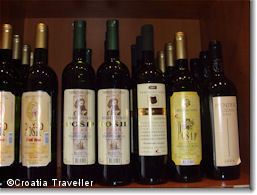Croatia now produces up to 700 wines, some of excellent quality. Purists may scoff, but Croatian have the habit of diluting their wine. In the south, they call it bevanda and in the north, they call it gemist.
Croatia Wine Regions
As in France, wines are strictly labeled according to their origin. There are some 300 official wine regions divided generally into coastal and interior wines. The majority (67%) of wine is white and produced in the interior while 32% is red and produced along the coast. Rose is relatively rare.
Croatian Grapes
Although there are hundreds of grape varieties in Croatia, experts agree that the red Plavac Mali grape produces the best red wine. Plavac Mali is genetically identical to Zinfandel grapes which clearly come from Croatia, not Italy as has long been thought. Croatia's sparkling Prosecco wine comes from Bogdanusa, a white grape. Malvazija from Istria and Posip from Korcula produce Croatia's most renowned white wines.
Croatia's Best Wines
In northern Croatia, look for Zlahtina from Vrbnik on Krk Island; Cabernet from Porec; Sauvignon, Merlot and Terrano from Buzet.
In Dalmatia look for Dingac and Postup from the Peljesac Peninsula, Babic from Primosten, Vugava from Vis, Plavac from Bol, Malmsy from Dubrovnik, Posip and Grg from Korcula.
Awards
In 2009, Croatia shocked the wine world by walking away with eight gold medals at the prestigious Decanter Wine Awards, beating out such stalwarts as Chile and New Zealand. Sweet, white wines won most of the medals. Wine judge Angela Muir described the dessert wines as" "exclusive, expensive, high-end and they are no question up with the great Sauternes." It's worth noting also the gold-medal winners come from continental Croatia, not the coast. Here are the winners
- Badel 1862 Graševina Daruvar 2007
- Bodren Château Bezanec Chardonnay 2007
- Bodren Couve 2007
- Bodren Pinot Sivi 2006
- Bodren Rajnski Rizling 2007
- Iloski Podrumi Tramanac 2006
- Krauthaker Graševina Izborna Berba 2007
- Krauthaker Zelenac Kutjevo Izborna Berba 2007
See the full list and commentary here.
Vineyards & Wine Tours
Peljesac Vineyards--great wine-tasting in a rustic, familial atmosphere
Villa Antonio--castle-hotel on a vineyard organizes visits to Peljesac wineries
Matosevic Wine Cellars --winery in Istria

Join the Croatia Traveller Group
Recommended Experiences
©CroatiaTraveller 2005-2024 All rights reserved
